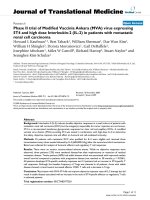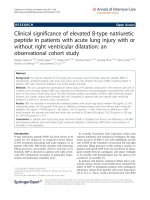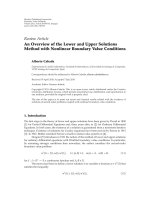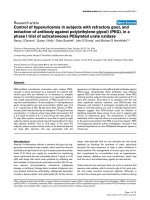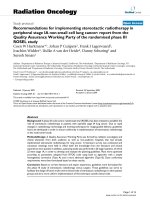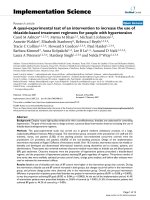FOXFIRE protocol: An open-label, randomised, phase III trial of 5-fluorouracil, oxaliplatin and folinic acid (OxMdG) with or without interventional Selective Internal Radiation Therapy (SIRT
Bạn đang xem bản rút gọn của tài liệu. Xem và tải ngay bản đầy đủ của tài liệu tại đây (339.06 KB, 7 trang )
Dutton et al. BMC Cancer 2014, 14:497
/>
STUDY PROTOCOL
Open Access
FOXFIRE protocol: an open-label, randomised,
phase III trial of 5-fluorouracil, oxaliplatin and
folinic acid (OxMdG) with or without interventional
Selective Internal Radiation Therapy (SIRT) as
first-line treatment for patients with unresectable
liver-only or liver-dominant metastatic colorectal
cancer
Susan J Dutton1, Nicola Kenealy2, Sharon B Love1, Harpreet S Wasan3, Ricky A Sharma4* and on behalf of the
FOXFIRE Protocol Development Group and the NCRI Colorectal Clinical Study Group
Abstract
Background: Colorectal cancer (CRC) is the second most common malignancy in Europe and a leading cause of
cancer-related death. Almost 50% of patients with CRC develop liver metastases, which heralds a poor prognosis
unless metastases can be downsized to surgical resection or ablation. The FOXFIRE trial examines the hypothesis
that combining radiosensitising chemotherapy (OxMdG: oxaliplatin, 5-fluorouracil and folic acid) with Selective
Internal Radiation Therapy (SIRT or radioembolisation) using yttrium-90 resin microspheres (SIR-Spheres®; Sirtex
Medical Limited, North Sydney, Australia) as a first-line treatment for liver-dominant metastatic CRC will improve
clinical outcomes when compared to OxMdG chemotherapy alone.
Methods/Design: FOXFIRE is an open-label, multicentre, randomised controlled trial of OxMdG with or without the
addition of SIRT (1:1 randomisation). Eligible adult patients have histologically confirmed colorectal adenocarcinoma,
liver metastases measurable on computed tomography scan and untreatable by either surgical resection or local
ablation, and they may have limited extra-hepatic disease, defined as ≤5 nodules in the lung and/or one other
metastatic site which is amenable to future definitive treatment. Eligible patients may have received adjuvant
chemotherapy following resection of the primary tumour, but are not permitted to have previously received
chemotherapy for metastatic disease, and must have a life expectancy of ≥3 months and a WHO performance
status of 0–1. The primary outcome is overall survival. Secondary outcomes include progression free survival (PFS),
liver-specific PFS, patient-reported outcomes, safety, response rate, resection rate and cost-effectiveness. FOXFIRE
shares a combined statistical analysis plan with an international sister trial called SIRFLOX.
(Continued on next page)
* Correspondence:
4
CRUK-MRC Oxford Institute for Radiation Oncology, NIHR Biomedical
Research Centre Oxford, Department of Oncology, University of Oxford, Old
Road Campus Research Building, Oxford, UK
Full list of author information is available at the end of the article
© 2014 Dutton et al.; licensee BioMed Central Ltd. This is an Open Access article distributed under the terms of the Creative
Commons Attribution License ( which permits unrestricted use, distribution, and
reproduction in any medium, provided the original work is properly credited. The Creative Commons Public Domain
Dedication waiver ( applies to the data made available in this article,
unless otherwise stated.
Dutton et al. BMC Cancer 2014, 14:497
/>
Page 2 of 7
(Continued from previous page)
Discussion: This trial is establishing a network of SIRT centres and ‘feeder’ chemotherapy-only centres to standardise the delivery of SIRT across the whole of the UK and to provide greater equity of access to this highly specialised
liver-directed therapy. The FOXFIRE trial will establish the potential role of adding SIRT to first-line chemotherapy for
unresectable liver metastatic colorectal cancer, and the impact on current treatment paradigms for metastatic CRC.
Trial registration: ISRCTN83867919
Keywords: Colorectal cancer, Liver metastases, Selective Internal Radiation Therapy (SIRT), Radio-embolization,
Brachytherapy, Radiosensitisation, Radiosensitization, Quality of life, Health economics
Background
Colorectal cancer is the second most common malignancy
in Europe and a leading cause of cancer-related deaths. In
the UK, it is the second most common cancer in women
after breast cancer, and the third in men after prostate and
lung cancer. Despite recent major advances in the systemic treatment of metastatic colorectal cancer (mCRC),
the 5-year overall survival (OS) remains disappointingly
low at approximately 12% [1]. Median survival for this patient group is currently 1.5-2.5 years, and depends on
continuation of chemotherapy for most of a patient’s
remaining life. Newly developed, expensive, biologically
targeted agents have had marginal effects in improving
survival and have not significantly affected the chances
of cure [2]. It is notable that in a subset of patients with
liver-only mCRC, in whom surgical resection of disease
can be achieved, the 5-year survival probability is 27-39%,
with 20% of patients achieving long-term cure [3-6].
Liver-directed strategies have been developed with the
aim of improving OS in patients with mCRC and liveronly or liver-dominant disease. Selective Internal Radiation
Therapy (SIRT or radioembolisation [RE]) is a technique
that targets multiple sites of disease within the liver as a
form of brachytherapy delivering high doses of ionising
radiation directly to the tumour whilst keeping radiation
exposure of the normal liver to a tolerable dose [7,8]. SIRSpheres® (Sirtex Medical Limited, North Sydney, Australia),
that contain the β-emitter yttrium-90, have EU approval
for use in inoperable liver cancer and have been utilised in
published phase I-II studies [9-11], which have demonstrated tolerability, high response rates and improved time
to progression versus chemotherapy alone.
In contrast to surgical resection and thermal ablation (e.g.
radiofrequency ablation or microwave), SIRT is not limited
by the number or sites of liver metastases. The technique of
SIRT involves an out-patient procedure in which a transfemoral catheterisation is performed and, in the case of
resin microspheres, approximately 40 to 80 million microspheres are injected into the arterial supply of the
liver under fluoroscopic guidance. This microsphere
infusion is secondary to a pre-treatment ‘work-up’ procedure: hepatic angiography with application of Technetium99 macro-aggregated albumin in conjunction with gamma
scintigraphy is used to predict microsphere distribution and
also ascertain the extent of hepatopulmonary shunting.
Whereas the normal liver receives the majority of its blood
supply from the portal venous system, liver tumours obtain
the majority of theirs from the hepatic artery. SIRT exploits
this vascular phenomenon, and as a consequence ensures
the deposition of the infused microspheres into the malignant microvasculature [7,8], delivering a high dose of radiation to tumour cells whilst relatively sparing the normal
liver parenchyma. The preferential lodging of microspheres
within tumour microvessels derived from the hepatic artery
has been demonstrated in patients treated with SIRT [8].
With escalating costs associated with multiple chemotherapies combined with biologics, and controversies
regarding sequencing and combination of drugs for optimal effect, the role of combining radiosensitisers with
liver-directed therapies needs to be defined. Reflecting
this, the National Institute of Clinical Excellence (NICE)
Interventional Guidance have emphasised the need for
research studies with outcome measures which include
survival “to reduce the current uncertainty about the efficacy of the procedure”.
The FOXFIRE trial will test the hypothesis that the
addition of SIRT to chemotherapy (OxMdG: oxaliplatin,
5-fluorouracil and folic acid) for patients with liver-only
or liver-dominant mCRC will show superiority when
compared to chemotherapy alone, in terms of efficacy,
safety and cost-effectiveness. Importantly, since the
greatest clinical benefit may be obtained from combining
radiotherapy with radiosensitising chemotherapy, FOXFIRE will combine SIRT with radiosensitising oxaliplatin
and 5-fluorouracil chemotherapy at doses defined clearly
in an earlier phase I-II study [11].
Methods/Design
The FOXFIRE trial will be conducted in accordance with
the Declaration of Helsinki, and all participating centres
must obtain the relevant approvals before patient enrolment. The FOXFIRE trial has been approved by the National Research Ethics Service Committee South Central –
Berkshire (REC reference: 09/H0505/1). The inclusion
and exclusion criteria for the FOXFIRE trial are summarised in Table 1.
Dutton et al. BMC Cancer 2014, 14:497
/>
Page 3 of 7
Table 1 FOXFIRE Inclusion/Exclusion criteria
Inclusion criteria
Exclusion criteria
1. Histologically confirmed colorectal cancer (CRC) with liver-only or
liver-dominant metastases not amenable to curative surgical resection
confirmed at a Multi-disciplinary team (MDT) meeting
1. Liver metastases amenable to curative resection, unless limited
EHD
2. Unequivocal & measurable CT evidence of liver metastases, not treatable
by surgical resection or local ablation with curative intent at time of trial
entry
2. Pregnant or breast-feeding
3. Age ≥ 18 years
3. Evidence of ascites, cirrhosis or portal hypertension
4. WHO performance status of 0–1
4. Main portal venous tumour involvement or thrombosis
5. Life expectancy > 3 months
5. Previous radiotherapy to upper abdomen or upper lumbar spine
6. Adequate haematological, renal and hepatic function
6. Other active malignancy within last 5 years [excluding colorectal
cancer and other non-melanoma skin cancers]
7. Eligible for systemic chemotherapy as 1st line treatment for metastatic CRC
7. Non-malignant disease that would render patient ineligible at the
discretion of the Investigator
8. Liver only/limited extra-hepatic disease (EHD): metastases in the lung must
not be more than 5 in number and should be, in the opinion of either the
local multi-disciplinary team (MDT) or following central review of scans
arranged via the Trials Office, amenable to future definitive local therapy. In
addition to lung metastases, a single site of other extra-hepatic disease is
permitted (e.g. multiple lymph nodes in one lymph node region) after
approval by the Trials Office.
8. Equivocal, immeasurable, or unevaluable liver metastases
9. Patients are permitted to have a primary colorectal tumour in situ, which
should be potentially resectable following protocol therapy
9. Unequivocal evidence of bone metastasis
10. Suitable for all aspects of treatment determined by clinical assessment
undertaken by Investigator
10. DLT associated with previous 5-FU or oxaliplatin chemotherapy
11. Using adequate contraception if pre-menopausal (male and
female patients)
11. Previous chemotherapy for metastatic colorectal cancer
[last dose of adjuvant chemotherapy for CRC administered
≥ 6 months pre-randomisation]
12. Willing & able to provide written informed consent
12. Peripheral neuropathy > CTCAE Grade 1
Overview of trial design
The FOXFIRE trial is a phase III, open label, multicentre,
parallel two-arm, randomised controlled trial of OxMdG
chemotherapy with or without the addition of interventional SIRT for patients with liver-only or liver-dominant
mCRC. Patients will be recruited at 34 UK centres with 20
being specialist SIRT centres and the remaining being
chemotherapy-only centres feeding into pre-specified
SIRT centres. Prior to site activation, all SIRT centres will
have treated at least three patients with SIRT to demonstrate that they have adequate training, support and
mentoring in place to perform the treatment safely. Eligible patients are randomised 1:1 to receive either systemic chemotherapy with oxaliplatin, 5-fluorouracil and
folic acid (OxMdG) or single-session whole liver SIRT +
OxMdG (Figure 1).
Randomisation and stratification
Following consent, eligible patients will be randomised 1:1
to OxMdG ± SIRT using a central computer system. Simple randomisation is used for the first 30 patients followed
by minimisation with a random element (0.8) [12] and
using the stratification factors: presence or absence of
extra-hepatic metastases, extent of tumour involvement
of the liver (≤25% or >25% tumour involvement
determined by computed tomography [CT] scan), investigational centre, and intention to treat with a biological
agent (introduced in March 2011 following a shift in the
international standard treatment paradigm for these
patients).
Protocol treatment
Systemic chemotherapy must start within 28 days of
randomisation. In the control arm, systematic chemotherapy with OxMdG consists of oxaliplatin (85 mg/m2
infusion over 2 hours), folinic acid (l-folinic acid 175 mg
or d, l-folinic acid 350 mg infusion over 2 hours) and
5-FU (400 mg/m2 bolus followed by a 2400 mg/m2 continuous infusion over 46 hours). This cycle is then repeated every 14 days for 12 cycles. In the treatment arm,
SIRT is administered on the third or fourth day of the
second chemotherapy cycle. In addition, the same
chemotherapy regimen is used except in cycles 2–4 when
the oxaliplatin dose was reduced to 60 mg/m2 as this has
been demonstrated as the maximum tolerated dose in an
earlier phase I-II trial [11]. SIRT requires a hepatic arteriogram and a liver-to-lung breakthrough nuclear medicine
scan to ensure suitability for receiving this procedure, and
to plan the delivery of the SIR-spheres. A separate SIRSpheres users’ manual details the technique for delivery of
Dutton et al. BMC Cancer 2014, 14:497
/>
Page 4 of 7
Control arm
Systemic chemotherapy
OxMdG ± biological agents*
Eligible
patients
Randomise
1:1
Intervention arm
SIR-Spheres® + systemic
chemotherapy OxMdG ±
biological agents*
Figure 1 Basic clinical trial schema for FOXFIRE clinical trial. Dose modification of oxaliplatin in the Intervention Arm is described in the main
text. *Biological agents (e.g. cetuximab or bevacizumab) are permitted from cycle 1 in the control arm or from cycle 7 in the intervention arm.
the SIR-Spheres. The prescribed activity of SIR-Spheres will
be determined from the patient’s body surface area (BSA),
the percentage tumour involvement, and the magnitude of
liver-to-lung shunting. The dosing charts used are consistent with a similar contemporary study (SIRFLOX study
protocol, submitted to BMC Cancer, March 2014).
The use of a licensed biological agent (e.g. cetuximab,
bevacizumab) is permitted in this trial at the discretion
of the treating investigator and at doses determined by
local practice, but the intention to treat a patient with a
biological agent should be declared at the time of randomisation. Intention to treat with a biological agent is a
stratification factor in the trial. The biological agent can
be added at any time during protocol chemotherapy for
patients randomised to chemotherapy only, but, on account of a potential interaction with liver radiotherapy,
it should not be delivered prior to cycle 7 for patients
randomised to receive SIRT.
Once protocol treatment is completed, patients should
be given the best available care based upon clinical assessment and patient preference. In both arms, if following
treatment response the patient is deemed a candidate for
surgical resection (assessed at 3 and 6 months after starting protocol treatment), and the patient undergoes surgical resection and/or complete ablation of their primary
and metastatic cancer, protocol OxMdG chemotherapy
should be continued as scheduled if appropriate.
Outcome measures and definitions
The primary endpoint of the FOXFIRE trial is a comparison of OS between treatment arms. Secondary endpoints
include safety, progression-free survival (PFS), liver-specific
PFS, response and resection rate, time until next therapy,
patient-reported outcomes (PROs) and cost-effectiveness.
All patients will be assessed by the criteria.
OS is defined as the time from randomisation until
death from any cause with patients censored at the last
date alive if they are not known to have died by the end
of the follow-up period. PFS is defined as the time from
randomisation until disease progression (RECIST version
1.1 guidelines [13]) or death from any cause with censoring at the last date alive and progression-free. PFS and
response rate will be determined from serial CT scans.
Sample scans are being collected from each centre for
central review as part of radiology quality assurance.
Liver-specific PFS is defined as for PFS but until documented progression in the liver. Adverse events (AEs) and
Serious Adverse Events (SAEs) will be collected and rated
according to Common Terminology Criteria for Adverse
Events (CTCAE) v3.0 and the relationship to protocol therapy will be rated as none, unlikely, possible or probable.
PROs are assessed using the generic EORTC Quality of
Life Questionnaire (QLQ-C30) and disease specific EORTC
QLQ-LMC21 with pre-specified outcomes of global quality
of life at 12 months and fatigue at cycle 4. Health economic
outcomes will be based upon the quality of life measured
by EQ-5D and collection of health economic data including
costs of chemotherapy and SIRT (including the use of
ancillary services and treatments), hospital visits, imaging,
surgical procedures, and in-patient lengths of stay.
Sample size calculation and statistical considerations
The entry criteria and trial design of FOXFIRE are sufficiently similar to the SIRFLOX clinical trial (SIRFLOX
study protocol, submitted to BMC Cancer, March 2014)
for the data from the two studies to be prospectively combined in a statistically valid way to improve the overall
utility of both studies in answering the key research questions. The original sample size calculation required a total
of 810 patients in order to observe 631 OS events with
80% power and two-sided 5% significance to detect a difference in median OS from 16 to 20 months (HR = 0.8),
and allowing for a 5% drop-out/loss to follow-up and assuming 3 years recruitment and 2 years follow-up.
It was originally planned to recruit this number of patients from both FOXFIRE (n = 490) and SIRFLOX (n =
320) and carry out a combined analysis for OS. Following changes to the treatment paradigm in liver metastatic colorectal cancer SIRFLOX allowed the use of
bevacizumab in suitable patients and the intention-to-
Dutton et al. BMC Cancer 2014, 14:497
/>
treat with bevacizumab was included as a stratification factor. FOXFIRE also allowed appropriate treatment with a
biological agent, including bevacizumab and cetuximab,
adding intention-to-treat with a biological agent as a stratification factor. The use of biological agents will potentially
prolong the PFS time and this has led to increasing the
sample size for PFS in SIRFLOX. Thus, the overall sample
size for the combined endpoint has been adjusted to take
into account changes in the expected median OS for the
control group. We therefore predict that 1022 patients will
be required to observe the 631 events required to detect a
hazard ratio of 0.8 with 80% power and two-sided 5% significance. This number of patients will include at least 320
patients recruited in FOXFIRE, 500 patients recruited in
SIRFLOX and the additional patients being recruited into
an extension study to SIRFLOX, called FOXFIRE-Global. It
is anticipated that the required number of participants will
have been recruited by October 2014.
All analyses will be conducted on an intention-to-treat
(ITT) basis. The primary endpoint of OS will be analysed
after all patients recruited into FOXFIRE and SIRFLOX
have been followed up for at least 2 years and at least 631
deaths have been observed. Analysis will be by KaplanMeier survival curves and unadjusted log-rank test. The
primary analysis will be a two-stage meta-analysis of individual patient data with the first stage consisting of within
trial analyses and the second stage being a pooled analysis
of the separate within trial analysis results. A secondary
analysis will be undertaken using the one-stage approach
also using individual patient data but for all patients, in
order to investigate other aspects of the trial and covariates. Response and resection rates will be compared using
test of proportions and the unadjusted log rank test will
be used to compare time to event endpoints. PROs will be
compared using ANCOVA adjusting for baseline values,
with pre-specified variables compared using 5% (2-sided)
significance and the other functional and symptom scales
assessed using 1% (2-sided) significance.
Sensitivity analyses will be performed adjusting for minimisation and prognostic factors and by trial (FOXFIRE/SIRFLOX) in a multivariate analysis framework. This includes
the impact of explanatory variables on various outcome
measures of interest. Proportional hazards regression will
be used to model time to event outcomes, multiple linear
regression to model continuous outcomes (with appropriate transformations if necessary) such as the PROs, logistic
regression to model binary outcomes (such as response)
and ordered logistic regression for ordered categorical outcomes (such as toxicity grades).
Planned interim analyses
The Data and Safety Monitoring Committee (DSMC) will
review the results from several interim analyses using data
from both the FOXFIRE and SIRFLOX trials, these
Page 5 of 7
include: analysis of toxicity and safety approximately
8 months after at least 80 patients are randomised (a minimum of 40 patients per trial); and analysis of toxicity and
safety approximately 8 months after at least 300 patients
are randomised (a minimum of 120 patients per trial).
Further specifics of all analyses will be agreed with the
DSMC and included in the statistical analysis plan.
Discussion
In their procedure guidance published in July 2011, The
UK National Institute for Health and Clinical Excellence
(NICE) stated that the evidence on the efficacy of SIRT in
chemotherapy-naïve patients was lacking and “Clinicians
should offer eligible patients who have not been previously
treated by chemotherapy entry into well-designed research
studies such as the FOXFIRE trial (www.octo-oxford.org.
uk/alltrials/trials/FOXFIRE).” FOXFIRE is the first clinical
study of SIRT to be powered to address an overall survival
endpoint and to include systematic evaluation of quality of
life and healthcare economics.
As the first multi-centre, phase III clinical trial of SIRT
in the UK, FOXFIRE has resulted in the establishment
of a national infrastructure for the safe delivery of SIRT
to patients with cancer, and “chemotherapy-only” centres who deliver FOXFIRE chemotherapy and refer their
patients to another centre for the SIRT procedure. This
pattern of specialist of SIRT centres and “chemotherapyonly” centres has improved equity of access to this clinical trial across the whole of the UK and is particularly
important for interventional oncology trials to maintain
adequate recruitment rates. Recruitment to FOXFIRE
was one of the factors used by NHS England in deciding
which 10 centres would be commissioned to deliver
SIRT as part of the Commissioning through Evaluation
programme for the 3rd and subsequent line therapy of
metastatic colorectal cancer [14].
SIRFLOX is a randomised multi-centre trial with participating centres in Australia, New Zealand, Europe and
the USA, evaluating the addition of SIR-spheres to FOLFOX chemotherapy for patients with non-resectable liver
metastases from primary colorectal carcinoma either
with or without evidence of extra-hepatic disease. FOLFOX is equivalent in drug doses to OxMdG but uses a
different delivery regimen with regard to the sequencing
of drugs. Discussion between the trial management
groups of the two trials led to the development of similar protocols and treatment paradigms in order to provide sufficient power for the prospective combined
analysis of the two trials for overall survival. This will be
carried out as a two-stage process: separate within trial
analyses followed by a meta-analysis pooling these results.
Additional analysis using the individual patient data will
also be undertaken. A combined statistical analysis plan
will be finalised prior to final OS datalock combining data
Dutton et al. BMC Cancer 2014, 14:497
/>
from the two trials. This result will be in addition to the
PFS being reported separately for SIRFLOX and FOXFIRE, anticipated in 2015 and 2016 respectively.
The need for robust quality of life information from
patients having SIRT was emphasised by NICE in its
guidance published in July 2011. To address this deficit
in the published literature, FOXFIRE has incorporated 3
quality of life instruments at 4 timepoints, plus annually,
as an important secondary endpoint of the clinical trial.
In addition to these data, a bespoke health economics
questionnaire is being collected at baseline and annually
to provide information about potential health economic
benefits for patients treated with SIRT.
FOXFIRE also includes translational substudies, including the collection of blood and tissue samples jointly
with the New-EPOC clinical trial (University of Southampton, UK: ISRCTN22944367) under the combined
Trans-EPOC award (separate grant from Cancer Research UK). The biobank being collected from FOXFIRE
represents the only tissue collection worldwide of liver
tissue post-radiotherapy and it represents a valuable resource for researchers to access via the Trans-EPOC trial
management group. A substudy of Perfusion Liver CT
in a subgroup of the FOXFIRE patients is also open to
recruitment and is gathering data to study the role of
this imaging modality in predicting response to chemotherapy and to SIRT (PERFORM, University of Oxford,
UK: NCT01410760). These translational and radiological
substudies will inform investigators how best to select
patients for SIRT and how to assess response.
In summary, the FOXFIRE trial is testing the hypothesis
that combining radiosensitising chemotherapy (OxMdG)
with SIRT using yttrium-90 resin microspheres as a
first-line treatment for liver-dominant metastatic CRC
will improve clinical outcomes when compared to OxMdG
chemotherapy alone.
Abbreviations
BSA: Body surface area; CEA: Carcino-embryonic antigen; CRC: Colorectal
cancer; CT: Computed tomography; 5-FU: 5-fluorouracil; HRQoL: Healthrelated quality of life; ITT: Intention-to-treat; MDT: Multi-disciplinary team;
OS: Overall survival; OxMdG: Oxaliplatin and modified de Gramont (5fluorouracil) chemotherapy; PFS: Progression-free survival; PRO: Patientreported outcome; RE: Radio-embolisation (also known as SIRT);
RECIST: Response evaluation criteria in solid tumours; SIRT: Selective internal
radiation therapy.
Competing interests
RAS has received research funding from Sirtex Medical Limited for the
FOXFIRE clinical trial. Other authors have declared no competing interests.
Authors’ contributions
RS and HSW conceived the FOXFIRE study, designed it with input from the
NCRI Colorectal Clinical Study Group, submitted it for funding from the
Bobby Moore Fund of Cancer Research UK, and drafted this manuscript. NK
is the Trial Coordinator and manages the day-to-day running of the trial
and drafted this manuscript. SBL and SD participated in the design and
organisation of the study and provided statistical advice and drafted this
manuscript. All authors read and approved the final draft of the manuscript
for submission.
Page 6 of 7
Acknowledgements
The FOXFIRE trial is sponsored by the University of Oxford and is funded the
Bobby Moore Fund of Cancer Research UK (CTAAC ref number: CRUK/
A16630), an educational grant from Sirtex Medical Ltd and the NIHR
Biomedical Research Centre Oxford. The trial is coordinated by the Oncology
Clinical Trials Office (OCTO) at the University of Oxford with statistical
support from the Centre for Statistics in Medicine, which together form part
of the Oxford Clinical Trials Research Unit (OCTRU), a UKCRC Registered
Clinical Trials Unit. Independent data and safety monitoring and trial steering
committees meet regularly to oversee the trial appropriately. We
acknowledge secretarial assistance provided by Martin Gilmour of ESP
Bioscience (Crowthorne, UK) during the preparation of this manuscript.
The Protocol Development Group: Trial management & Quality assurance:
Mrs Sarah Pearson, OCTO, University of Oxford, Dr Joanna Black, OCTO,
University of Oxford, Dr Luise Dunham, OCTO, University of Oxford; Nursing
Advisor: Dr Anne Roberts, Addenbrookes Hospital; Nuclear Medicine: Dr Val
Lewington, St Thomas’ Hospital, Dr Adil Al-Nahhas, Hammersmith Hospital;
Oncology: Dr Rachel Midgley, University of Oxford, Prof David Kerr, University
of Oxford; Dr Ian Chau, Royal Marsden Hospital, Dr Greg Wilson, Christie
Hospital, Prof Will Steward, University of Leicester; Interventional Radiology:
Dr Paul Tait, Hammersmith Hospital, Dr Nas Khan, Chelsea & Westminster
Hospital; Hepatic Surgery: Mr Dave Berry, University Hospital of Wales;
Pathology: Dr Andy Wotherspoon, Royal Marsden Hospital; Diagnostic
Radiology: Dr Bruno Morgan, University Hospitals of Leicester; Health
Economics: Prof Alastair Gray, Dr Jane Wolstenholme, University of Oxford.
Author details
1
Centre for Statistics in Medicine, Nuffield Department of Orthopaedics,
Rheumatology and Musculoskeletal Sciences, University of Oxford, Oxford,
UK. 2Oncology Clinical Trials Office, Department of Oncology, University of
Oxford, Oxford, UK. 3Imperial College Healthcare NHS Trust, Hammersmith
Hospital, London, UK. 4CRUK-MRC Oxford Institute for Radiation Oncology,
NIHR Biomedical Research Centre Oxford, Department of Oncology,
University of Oxford, Old Road Campus Research Building, Oxford, UK.
Received: 4 April 2014 Accepted: 30 June 2014
Published: 9 July 2014
References
1. SEER Stat Fact Sheets: Colon and Rectum Cancer, 2003–2009.
[ />2. Peeters M, Price T: Biologic therapies in the metastatic colorectal cancer
treatment continuum–applying current evidence to clinical practice.
Cancer Treat Rev 2012, 38(5):397–406.
3. Abbas S, Lam V, Hollands M: Ten-year survival after liver resection for
colorectal metastases: systematic review and meta-analysis. ISRN Oncol
2011, 2011:763245.
4. Fong Y, Fortner J, Sun RL, Brennan MF, Blumgart LH: Clinical score for
predicting recurrence after hepatic resection for metastatic colorectal
cancer: analysis of 1001 consecutive cases. Ann Surg 1999, 230(3):309–318.
discussion 318–321.
5. Choti MA, Sitzmann JV, Tiburi MF, Sumetchotimetha W, Rangsin R, Schulick RD,
Lillemoe KD, Yeo CJ, Cameron JL: Trends in long-term survival following liver
resection for hepatic colorectal metastases. Ann Surg 2002, 235(6):759–766.
6. Nordlinger B, Van Cutsem E, Gruenberger T, Glimelius B, Poston G, Rougier P,
Sobrero A, Ychou M, European Colorectal Metastases Treatment Group; Sixth
International Colorectal Liver Metastases Workshop: Does chemotherapy prior
to liver resection increase the potential for cure in patients with metastatic
colorectal cancer? A report from the European Colorectal Metastases
Treatment Group. Eur J Cancer 2007, 43(14):2037–2045.
7. Nicolay NH, Berry DP, Sharma RA: Liver metastases from colorectal cancer:
radioembolization with systemic therapy. Nat Rev Clin Oncol 2009,
6(12):687–697.
8. Wang LM, Jani AR, Hill EJ, Sharma RA: Anatomical basis and
histopathological changes resulting from selective internal radiotherapy
for liver metastases. J Clin Pathol 2013, 66:205–211.
9. Gray B, Van Hazel G, Hope M, Burton M, Moroz P, Anderson J, Gebski V:
Randomised trial of SIR-Spheres plus chemotherapy vs. chemotherapy
alone for treating patients with liver metastases from primary large
bowel cancer. Ann Oncol 2001, 12(12):1711–1720.
Dutton et al. BMC Cancer 2014, 14:497
/>
Page 7 of 7
10. Van Hazel G, Blackwell A, Anderson J, Price D, Moroz P, Bower G, Cardaci G,
Gray B: Randomised phase 2 trial of SIR-Spheres plus fluorouracil/leucovorin chemotherapy versus fluorouracil/leucovorin chemotherapy alone
in advanced colorectal cancer. J Surg Oncol 2004, 88(2):78–85.
11. Sharma RA, Van Hazel GA, Morgan B, Berry DP, Blanshard K, Price D,
Bower G, Shannon JA, Gibbs P, Steward WP: Radioembolization of liver
metastases from colorectal cancer using yttrium-90 microspheres with
concomitant systemic oxaliplatin, fluorouracil, and leucovorin chemotherapy.
J Clin Oncol 2007, 25(9):1099–1106.
12. Brown S, Thorpe H, Hawkins K, Brown J: Minimization - reducing
predictability for multi-centre trials whilst retaining balance within
centre. Stat Med 2005, 24(24):3715–3727.
13. Eisenhauer EA, Therasse P, Bogaerts J, Schwartz LH, Sargent D, Ford R,
Dancey J, Arbuck S, Gwyther S, Mooney M, Rubinstein L, Shankar L, Dodd L,
Kaplan R, Lacombe D, Verweij J: New response evaluation criteria in solid
tumours: revised RECIST guideline (version 1.1). Eur J Cancer 2009,
45(2):228–247.
14. NHS England announces hospitals chosen to take part in new initiative
aimed at increasing access to radiotherapy. />2013/11/20/sirt-comm.
doi:10.1186/1471-2407-14-497
Cite this article as: Dutton et al.: FOXFIRE protocol: an open-label,
randomised, phase III trial of 5-fluorouracil, oxaliplatin and folinic acid
(OxMdG) with or without interventional Selective Internal Radiation
Therapy (SIRT) as first-line treatment for patients with unresectable
liver-only or liver-dominant metastatic colorectal cancer. BMC Cancer
2014 14:497.
Submit your next manuscript to BioMed Central
and take full advantage of:
• Convenient online submission
• Thorough peer review
• No space constraints or color figure charges
• Immediate publication on acceptance
• Inclusion in PubMed, CAS, Scopus and Google Scholar
• Research which is freely available for redistribution
Submit your manuscript at
www.biomedcentral.com/submit
